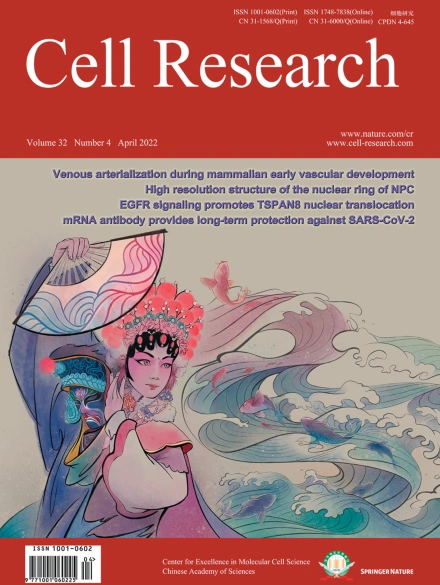
Advanced Search
Submit Manuscript
Advanced Search
Submit Manuscript
Volume 32, No 4, Apr 2022
ISSN: 1001-0602
EISSN: 1748-7838 2018
impact factor 17.848*
(Clarivate Analytics, 2019)
Volume 32 Issue 4, April 2022: 383-400 |
Generation and characterization of stable pig pregastrulation epiblast stem cell lines
Minglei Zhi1,† , Jinying Zhang1,† , Qianzi Tang2,† , Dawei Yu3,4,5,† , Shuai Gao6,† , Dengfeng Gao1 , Pengliang Liu2 , Jianxiong Guo7 , Tang Hai3 , Jie Gao1 , Suying Cao8 , Zimo Zhao1 , Chongyang Li3 , Xiaogang Weng9 , Mengnan He2 , Tianzhi Chen1 , Yingjie Wang1 , Keren Long2 , Deling Jiao7 , Guanglei Li10 , Jiaman Zhang2 , Yan Liu9 , Yu Lin2 , Daxin Pang11 , Qianqian Zhu1 , Naixin Chen1 , Jingjing Huang1 , Xinze Chen1 , Yixuan Yao1 , Jingcang Yang8 , Zicong Xie11 , Xianya Huang8 , Mengxin Liu8 , Ran Zhang1 , Qiuyan Li1 , Yiliang Miao12 , Jianhui Tian6,10,11 , Bofeng Liu13 , Wei Xie13 , Qi Zhou3,16 , Hongjiang Wei7,16 , Zhonghua Liu9,* , Caihong Zheng14,* , Mingzhou Li2,* , Jianyong Han1,*
1State Key Laboratory of Agrobiotechnology, College of Biological Sciences, China Agricultural University, Beijing, ChinaPig epiblast-derived pluripotent stem cells are considered to have great potential and broad prospects for human therapeutic model development and livestock breeding. Despite ongoing attempts since the 1990s, no stably defined pig epiblast-derived stem cell line has been established. Here, guided by insights from a large-scale single-cell transcriptome analysis of pig embryos from embryonic day (E) 0 to E14, specifically, the tracing of pluripotency changes during epiblast development, we developed an in vitro culture medium for establishing and maintaining stable pluripotent stem cell lines from pig E10 pregastrulation epiblasts (pgEpiSCs). Enabled by chemical inhibition of WNT-related signaling in combination with growth factors in the FGF/ERK, JAK/STAT3, and Activin/Nodal pathways, pgEpiSCs maintain their pluripotency transcriptome features, similar to those of E10 epiblast cells, and normal karyotypes after more than 240 passages and have the potential to differentiate into three germ layers. Strikingly, ultradeep in situ Hi-C analysis revealed functional impacts of chromatin 3D-spatial associations on the transcriptional regulation of pluripotency marker genes in pgEpiSCs. In practice, we confirmed that pgEpiSCs readily tolerate at least three rounds of successive gene editing and generated cloned gene-edited live piglets. Our findings deliver on the long-anticipated promise of pig pluripotent stem cells and open new avenues for biological research, animal husbandry, and regenerative biomedicine.
https://doi.org/10.1038/s41422-021-00592-9